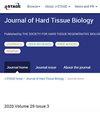局部使用冻干透明质酸片促进仓鼠口腔黏膜炎模型的愈合
IF 0.4
4区 医学
Q4 ENGINEERING, BIOMEDICAL
引用次数: 0
摘要
使用抗癌药物或放射治疗头颈部肿瘤常引起口腔黏膜炎,并伴有严重的粘膜疼痛。透明质酸(HA)是临床上用于治疗口腔黏膜炎的保湿剂;然而,由于其液体性质,透明质酸不能长期留在粘膜炎区域。我们最近使用冷冻干燥方法开发了原始的HA片状。在这项研究中,我们用动物模型评估了局部应用新开发的透明质酸片对口腔黏膜炎愈合的影响。用醋酸浸泡过的滤纸涂抹于6周龄雄性叙利亚仓鼠颊袋,诱导实验性口腔黏膜炎。在确定获得可用于评估愈合过程的均匀粘膜炎区域的适当条件后,比较三组,从宏观和组织病理学上评估HA片对口腔粘膜炎愈合的影响:HA组,从黏膜炎诱导后第二天开始将HA片应用于粘膜炎区域;羧甲基纤维素(CMC)对照组用CMC片处理;另一组是没有使用床单的对照组。与对照组相比,HA组在第2-4天粘膜炎区域明显缩小。第2天的组织病理学分析显示,与对照组和CMC组相比,HA组口腔黏膜上皮轻度炎症细胞浸润,水肿改变减轻,部分再生,浅层胶原纤维平行粗束。总之,我们建立了一个仓鼠口腔黏膜炎模型,可以方便地评估愈合过程。每日局部应用冻干透明质酸片加速了该仓鼠模型口腔黏膜炎的愈合。这些结果表明,透明质酸片可能是治疗癌症患者口腔黏膜炎的有效材料。本文章由计算机程序翻译,如有差异,请以英文原文为准。
Topical Administration of Freeze-Dried Sheets of Hyaluronic Acid Promotes the Healing of Oral Mucositis in a Hamster Model
Treatment of tumors in the head and neck region using anticancer agents or radiotherapy often causes oral mucositis, which is associated with severe mucosal pain. Hyaluronic acid (HA) is a moisturizing agent used clinically to treat oral mucositis; however, HA does not remain long-term in the mucositis region due to its liquid nature. We recently developed the original sheet form HA using a freeze-drying method. In this study, we evaluated the effect of topical application of the newly developed HA sheets on oral mucositis healing using an animal model. Experimental oral mucositis was induced in 6-week-old male Syrian hamsters by applying filter paper soaked with acetic acid to the cheek pouches. After determining the appropriate conditions for obtaining uniform mucositis region useful for evaluating the healing process, the effect of HA sheets on oral mucositis healing were evaluated macroscopically and histopathologically comparing three groups: an HA group, in which HA sheets were applied to the mucositis region from the second day after mucositis induction; a carboxymethylcellulose (CMC) control group treated with CMC sheets; and a control group in which no sheets were applied. Compared to the control group, the HA group exhibited significantly smaller mucositis region on Days 2-4. Histopathology analysis on Day 2 showed mild inflammatory cell infiltration, reduced edematous changes, partial regeneration of the oral mucosal epithelium, and parallel thick bundles of collagen fibers in the superficial layer in the HA group compared with the Control and CMC groups. In conclusion, a hamster oral mucositis model was established that allows for convenient evaluation of the healing process. Daily topical application of freeze-dried sheets of HA accelerated the healing of oral mucositis in this hamster model. These results suggest that HA sheets could be an effective material in the treatment of oral mucositis in cancer patients.
求助全文
通过发布文献求助,成功后即可免费获取论文全文。
去求助
来源期刊

Journal of Hard Tissue Biology
ENGINEERING, BIOMEDICAL-
CiteScore
0.90
自引率
0.00%
发文量
28
审稿时长
6-12 weeks
期刊介绍:
Information not localized
 求助内容:
求助内容: 应助结果提醒方式:
应助结果提醒方式:


